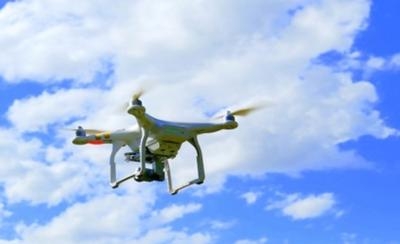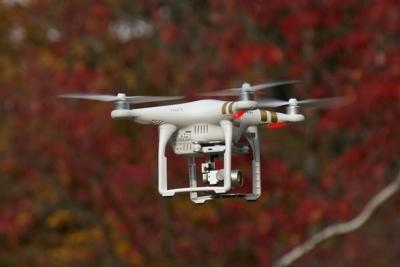Center For Unmanned Systems Technologies To Provide Opportunities For Students
As drones become more popular and affordable, San Diego State University’s new Center for Unmanned Systems Technologies, or Drone Lab for short, is looking to capitalize on its potential for crowd protection, surveillance and research while heading off potential dangers.

“We want to make SDSU a drone-friendly campus, but we want to do so safely,” said Lamine Secka, director of emergency services and Drone Lab program manager. “The goal of the Drone Lab is to get people thinking about ways to use drones that they may have never imagined before.”
On the campus safety side of things, that means using aerial drones to hover over outdoor concerts or other large gatherings and monitor for signs of violence or people in distress. These UAVs can provide not only eyes in the sky for security personnel but also can shine spotlights or deliver directions or warnings via mounted loudspeakers.
Drones can offer a bird’s-eye view of field sites, ocean patterns, environmental degradation, traffic, crowd size, and many other things that may help researchers answer scholarly questions. Secka hopes the drone lab will be a resource for researchers interested in learning how drones might benefit their work, even if they’ve never flown one before.
The lab currently has access to nine UAVs of various sizes, configurations and specializations, but interested parties are welcome to bring their own personal drones to collaborate on projects.
According to Secka, students also frequently ask about drone usage on campus. Some use their drones for aerial photography, while others race or just fly them for fun. Too many drones flying around—especially flown by inexperienced pilots—represents a safety hazard, though. So another reason the Drone Lab was created was to provide a centralized hub to connect drone users and ensure that they are using the devices safely.
The university’s Buildings and Grounds Policy stipulates that all drones flown on campus must be registered through Emergency Services or the SDSU Police Department. The lab is currently working to develop an app that students can use to register their drones.

There are two designated “fly zones” on campus: the Exercise and Nutrition Sciences Field and the new Recreation Field located just north of Parking Structure 12. Flying on other parts of campus requires clearance from Emergency Services.
The Drone Lab was made possible by an establishing gift from the Aztec Parents Advisory Board. Efforts to secure funding were led by board member Terry Parisher, who runs an unmanned vehicle engineering and developing company called Straight Up Imaging and whose two daughters attend SDSU.
“San Diego has a national reputation as a hub for drone development so it makes sense for SDSU to have a center dedicated to drone use and research,” said Parisher, who has operated and developed drones for 14 years for both government and commercial applications. “We have dozens of companies that offer services, engineering and research with drones.”
Thanks to the partnership with the local drone industry, students not only gain access to the latest technology, but also to internship and employment opportunities. Through working with the community, SDSU can help fend off the idea that drones are inherently scary and invasive.
“With community involvement, you get community acceptance,” Parisher said. “When you have that, you have a much easier time integrating drones into the airspace.”
(Source: SDSU news release. Image from file)
 ANN's Daily Aero-Term (04.25.24): Airport Rotating Beacon
ANN's Daily Aero-Term (04.25.24): Airport Rotating Beacon ANN's Daily Aero-Linx (04.25.24)
ANN's Daily Aero-Linx (04.25.24) Klyde Morris (04.22.24)
Klyde Morris (04.22.24) Airborne 04.24.24: INTEGRAL E, Elixir USA, M700 RVSM
Airborne 04.24.24: INTEGRAL E, Elixir USA, M700 RVSM Airborne 04.22.24: Rotor X Worsens, Airport Fees 4 FNB?, USMC Drone Pilot
Airborne 04.22.24: Rotor X Worsens, Airport Fees 4 FNB?, USMC Drone Pilot




